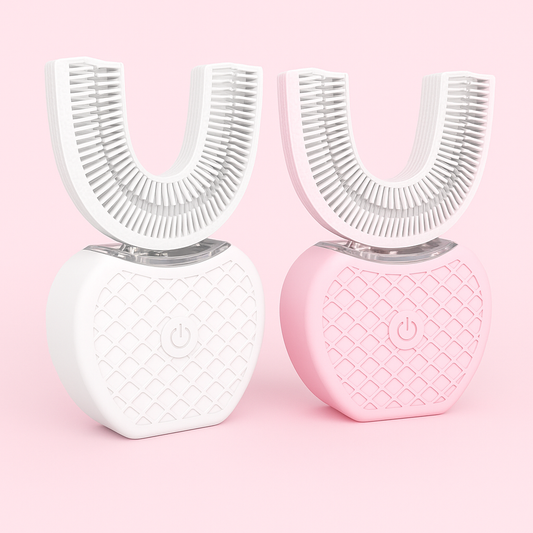Introduction: A modern, gentle path to whiter teeth without fluoride
Interest in fluoride-free oral care continues to grow as people seek alternatives that are gentle, microbiome-friendly, and compatible with sensitivity concerns. One rising strategy is a fluoride-free oral care "stack" built around niacinamide (vitamin B3) and xylitol. When paired with low-abrasion whitening formulations and good technique, this combination can support surface stain reduction, healthier gums, and a brighter smile without peroxide or fluoride.
This long-form guide explains the science, practical routines, product selection, safety considerations, and realistic expectations so you can confidently try a fluoride-free approach that prioritizes both oral health and gentle whitening.
Key takeaways
- Niacinamide and xylitol can work together to improve gum comfort and reduce cavity-associated bacteria while supporting gradual surface whitening.
- Fluoride-free whitening aims at surface stain removal and improved oral environment—not instant bleach-like whitening.
- Choose low-RDA (soft/low-abrasion) products, use good technique, and maintain dental check-ups for best results and safety.
- Products that match this approach include niacinamide toothpastes, xylitol-containing toothpastes and rinses, and gentle polishing pastes; consider reputable suppliers like Havana Body for ready-made options.
How niacinamide and xylitol help your mouth: the science, simply explained
- Xylitol: A naturally occurring sugar alcohol, xylitol is not fermented by the acid-producing bacteria that cause cavities (such as Streptococcus mutans). Regular xylitol exposure can reduce bacterial adherence and acid production, support healthier saliva balance, and lower cavity risk when used consistently as part of oral care.
- Niacinamide (vitamin B3): Known for anti-inflammatory and barrier-supporting effects on skin, niacinamide in oral formulations aims to soothe gum tissues, reduce sensitivity, and improve tolerance of daily hygiene. While dental research is still developing, niacinamide’s calming properties may help people maintain consistent brushing and whitening routines.
- Surface whitening vs. bleaching: Fluoride-free stacks focusing on niacinamide and xylitol typically target surface stains (coffee, tea, food pigments) through gentle polishing agents and consistent plaque/biofilm control. These approaches improve perceived whiteness gradually rather than delivering the rapid oxidizing action of peroxide-based bleaches.
What the research says (overview)
- Multiple clinical studies and reviews show xylitol reduces levels of cavity-associated bacteria and can lower caries incidence with habitual use.
- Evidence for niacinamide specifically in oral care is emerging; existing studies and product formulations focus on its anti-inflammatory, barrier-supporting benefits rather than direct whitening effects.
- Low-abrasion, consistent mechanical cleaning (brushing + flossing) is a cornerstone for both oral health and surface stain control — ingredients help, but technique matters most.
Ingredients to include — and avoid — in a fluoride-free whitening stack
-
Good to include:
- Xylitol (toothpaste, lozenges, rinse)
- Niacinamide in low-to-moderate concentrations (toothpaste or rinse)
- Low-RDA polishing agents (hydrated silica, calcium carbonate in mild grades)
- Enzymes (amylase, lactoperoxidase) in some oral care lines that support biofilm balance
- Alcohol-free, non-drying mouthwashes
-
Use with caution or avoid:
- High-abrasivity agents (coarse charcoal, heavy polishing powders) — these can abrade enamel over time.
- Unsupervised at-home high-concentration peroxide (if you want to remain peroxide-free).
- Rinses or products with high alcohol content that dry the mouth — dry mouth can increase staining and decay risk.
Building the optimal fluoride-free care stack
Below is a practical, day-to-day product stack you can assemble. Customize based on sensitivity, staining habits, and professional advice.
- Niacinamide toothpaste: A low-abrasion daily toothpaste that lists niacinamide on the label and targets gum comfort and sensitivity.
- Xylitol toothpaste: A toothpaste that uses xylitol as the primary sweetener and active anti-caries adjunct.
- Gentle whitening/polishing paste: Low-RDA polishing paste for weekly or alternate-day polishing to remove surface stains without heavy abrasion.
- Alcohol-free xylitol mouthwash: Use after meals or for mid-day refresh; helps maintain saliva balance and reduces bacteria rebound.
- Soft-bristled toothbrush: Electric or manual with soft bristles to improve plaque removal while limiting abrasion.
- Interdental cleaners (floss, picks, water flosser): Daily removal of interdental plaque is essential to keep stains from setting.
Detailed morning-to-night routine (fluoride-free)
-
Morning:
- Rinse with water if needed after overnight dryness.
- Brush 2 minutes with your niacinamide + xylitol toothpaste—focus on technique: gentle circular strokes, not hard scrubbing.
- Rinse and follow with an alcohol-free xylitol mouthwash for breath and saliva support.
-
Midday:
- After stain-prone foods or beverages, rinse with water or a xylitol rinse to reduce pigment adherence.
- Use chewing gum with xylitol (sugar-free) to stimulate saliva and help clear debris.
-
Evening:
- Floss or use interdental cleaners to remove plaque and stain sources between teeth.
- Brush again for 2 minutes—if sensitivity is present, use niacinamide formulation; if not, alternate with the low-RDA polishing paste 2–3 times per week for enhanced surface stain removal.
- Finish with a xylitol rinse if desired. Avoid eating or drinking for 30 minutes after brushing to let actives work.
- Weekly: Once or twice weekly, use a gentle polishing paste for additional stain control — do not overuse polishing products to avoid enamel wear.
- Monthly/As-needed: Consider professional cleaning when stains persist or every 3–6 months as recommended by your dentist.
Technique, tools, and tips to maximize whitening safely
- Brush gently with a soft-bristled brush and use a two-minute timer to ensure adequate cleaning without abrasion.
- Replace your toothbrush or brush head every 3 months or when bristles splay.
- Aim for consistent daily flossing — interdental stain control is critical for overall whiteness.
- Delay brushing for 30 minutes after acidic foods/drinks to avoid abrasion of softened enamel.
- Use stain-reducing habits: drink staining beverages through a straw when possible, rinse after them, and limit prolonged sipping.
Diet and lifestyle choices that support a whiter smile
- Reduce frequency of exposure to highly pigmented foods and drinks (coffee, tea, red wine, berry sauces). When you do consume them, rinse with water afterward.
- Increase crunchy fruits and vegetables (apples, carrots) that help mechanical plaque cleaning and stimulate saliva.
- Stay hydrated to support saliva flow—saliva protects enamel and helps clear stains.
- Quit smoking or using tobacco — tobacco causes heavy staining and substantially increases oral disease risk.
Special situations: sensitivity, restorations, smokers, and braces
- Sensitivity: Niacinamide formulations can reduce sensitivity for some people. Avoid harsh abrasives and use desensitizing products as advised by your dentist.
- Restorations and crowns: Whitening pastes and stacks improve natural tooth surface brightness, but they do not change the color of veneers, crowns, or composite restorations. Consult your dentist before changing routines if you have restorations.
- Orthodontics: With braces, prioritize plaque control around brackets using interdental brushes and water flossers; once braces come off, professional cleaning often improves whitening quickly.
- Smokers: Expect slower and tougher stain removal; combining good hygiene with professional cleanings provides the best results.
DIY options and safe home additions
If you prefer to DIY certain parts of your routine, consider these low-risk additions—always exercise caution and consult your dentist for children or complex conditions.
- Xylitol rinse: Dissolve 1–2 teaspoons of powdered xylitol in a cup (240 ml) of warm water; use as a mid-day rinse. Do not give concentrated xylitol solutions to pets — xylitol is highly toxic to dogs.
- Chewing gum with xylitol: Chew after meals to increase saliva and reduce acid exposure; choose products with at least 1 gram xylitol per piece for benefit.
- Avoid homemade abrasive mixtures (baking soda + acid, charcoal scrubs) used frequently — they can increase enamel wear if used improperly.
How to choose products: an SEO-friendly checklist
When shopping, look for these keywords and product phrases that match a safe, effective fluoride-free approach:
- 'toothpaste without fluoride'
- 'toothpaste with xylitol'
- 'niacinamide toothpaste'
- 'fluoride-free whitening toothpaste'
- 'best toothpaste for whiter teeth' and 'toothpaste that whitens teeth' (use with product reviews and RDA info)
- 'low RDA' or 'soft polishing' on the label
For convenience and tested formulations, consider reputable suppliers that specialize in fluoride-free, xylitol-forward oral care. For example, Havana Body offers targeted options that align with this stack—search their line for 'toothpaste without fluoride', 'toothpaste with xylitol', and 'niacinamide toothpaste' to get started.
Comparing professional whitening vs. a fluoride-free home stack
- Professional whitening: In-office bleaching (peroxide-based) produces faster and more dramatic shade changes. It’s supervised and can be tailored to avoid sensitivity but uses peroxide chemistry that some people avoid.
- Fluoride-free home stack: Focuses on safer daily maintenance, stain control, and gum comfort. It produces gradual improvements and is ideal for sensitive mouths or those avoiding peroxide/fluoride chemistry.
- Best practice: If you desire a significant shade change, consult your dentist. You can often combine professional whitening (under supervision) with a fluoride-free maintenance routine afterward to preserve results.
Common questions (FAQ)
- Will xylitol whiten teeth? Xylitol helps by reducing bacteria and supporting saliva, which indirectly reduces stain formation. It’s not a bleaching agent but contributes to a cleaner surface that looks brighter over time.
- How quickly will I see results? Expect incremental improvements over weeks to months. Surface stains respond sooner than intrinsic discoloration.
- Is niacinamide safe to use daily? In oral care concentrations, niacinamide is generally well tolerated. Stop use if irritation occurs and consult a healthcare professional.
- Can children use this stack? Follow pediatric dentist guidance—young children have different fluoride recommendations; xylitol is used in some pediatric protocols but dosing and supervision matter.
Safety notes and when to see your dentist
- If you have active decay, many dentists still recommend fluoride as a preventive treatment—discuss alternatives before stopping fluoride entirely.
- See a dentist for persistent bleeding, pain, sudden tooth color changes, or if you notice new sensitivity.
- Store xylitol products away from pets. Xylitol is safe for humans in recommended oral doses but can be extremely dangerous for dogs even in small amounts.
Product examples and shopping tips
When reviewing products, look for third-party testing, clear ingredient lists, and RDA values if available. Reviews and verified customer photos can help you judge real-world whitening outcomes. If you prefer a ready-made curated option, explore Havana Body’s formulations designed for fluoride-free whitening and oral comfort; they list xylitol and other supportive ingredients and can be found via their site links labeled for convenience.
Troubleshooting: common problems and fixes
- Little or no improvement: Re-evaluate brushing technique, frequency, and dietary staining habits. Increase professional cleanings if stubborn extrinsic stains persist.
- Increased sensitivity: Reduce polishing frequency, switch to niacinamide-specific toothpaste, and avoid acidic rinses immediately before brushing.
- Gum irritation: Stop the offending product and consult your dentist. Niacinamide usually calms gums, so new irritation could indicate another ingredient.
Final thoughts and how to get started
A fluoride-free oral care stack centered on niacinamide and xylitol is a practical, gentle approach to improving surface whiteness and oral comfort. It prioritizes reduced bacterial activity, improved saliva balance, and lower abrasion—key factors for sustainable, healthy-looking teeth. This approach won’t produce overnight bleaching results, but with consistent use, good technique, and occasional professional care, many people see meaningful improvements in brightness and gum comfort.
Call to action: try a curated fluoride-free option
If you’re ready to try a convenient, pre-formulated fluoride-free routine that follows the principles in this guide, explore Havana Body’s selection of xylitol-forward, niacinamide-containing oral care products. Their lineup includes options labeled for 'toothpaste that whitens teeth', 'toothpaste without fluoride', and 'toothpaste with xylitol' so you can start a gentle whitening regimen with trusted products. Visit Havana Body to browse and buy formulations designed to help you achieve healthier, whiter teeth while avoiding fluoride and peroxide.


